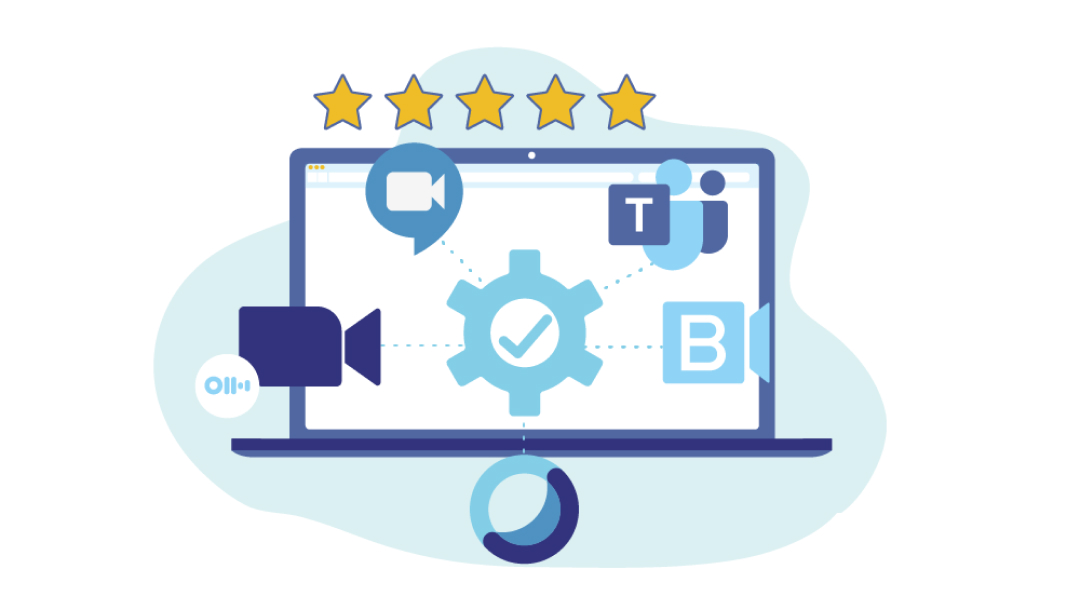The Top 8 Meeting Scheduling Software for 2025

How many emails does it take to schedule your average meeting?
With such full inboxes and busy schedules, it might take days of back-and-forth to find a shared slot — even if it’s only for a 30-minute slot.
If this sounds like you, we have the solution: meeting scheduling software. These tools streamline the booking process by highlighting availability, syncing calendars, and integrating with the tools you already use.
Here are the eight best options out there.
How to choose the best meeting scheduling software
Finding a tool that saves you time and energy is always a plus. Here are several factors to consider when choosing which solution is the right one for you:
- Ease of use: The best schedule apps are intuitive, letting you set up and organize meetings with minimal effort. It should be clear from the get-go how to set meetings to recur, add members, or reschedule for a later date.
- Views of other calendars: Try to choose a tool that lets you check out others’ calendars for focus time and free slots, making sure everyone is available at the proposed time. This is especially important for businesses where multiple team members need to coordinate on tight timelines.
- Pricing: Many meeting scheduling software tools offer a free plan with basic features, like group scheduling and automatic reminders. But if you need advanced functionalities such as branding, meeting analytics, or team-wide use, expect to pay for a premium plan.
- Integrations: Make sure the tool integrates with the apps you use most, such as Outlook, Zoom, or Slack. Plus, the ability to sync with Google and other calendars can ensure all meeting participants are on the same page.
- Customization and branding: A good appointment schedule app should allow you to edit meeting invites, create booking page links, and adjust the availability for different meeting types to communicate a cohesive brand identity. This level of customization is particularly important for consultants or independent contractors who want to show clients who they are and what they do.
- Automation and notifications: Automation is key in any scheduling software because it’s the feature that truly saves you time. Look for tools that automatically send invites, notifications, and reminders to avoid double booking without constant back-and-forth.
- Integration with other tools: The best meeting software connects to tools you already use, like your messaging platform, to keep everyone on the same page. But don’t forget about meeting assistant integrations — like Otter. Otter can sync with calendar events and automatically join on your behalf, providing a real-time transcript and sending attendees summaries after everyone signs off.
The 8 best meeting scheduling tools for 2025
Here’s a list of eight scheduling apps that stand out for their ability to simplify the scheduling process, whether you're coordinating internal team discussions, client appointments, or large events.
- Zoho Bookings
Zoho is a cloud-based customer relationship management software (CRM) that also supports sales, marketing, and customer support. Having all of these functions in one place streamlines operations and improves productivity.
Zoho Bookings is its appointment scheduling software — ideal for businesses already using Zoho’s ecosystem. It makes it easy for enterprises to schedule meetings with multiple attendees, both internal and external, like clients, sales leads, or partners.
- Pros: Highly customizable, integrates with Zoho CRM, easy to use
- Cons: Fewer third-party integrations compared to other tools
- Pricing: Zoho offers a free plan, but Bookings is only available with paid plans, starting at $8/month per member
- Google Calendar
For companies using Google Suite, Google Calendar is an obvious choice. But it’s also a great option for anyone needing an easy-to-use scheduling tool.
Google Calendar offers basic scheduling features, including the ability to check your team members’ availabilities, and integrates with popular tools like Slack. Plus, any meeting invites you attach to a Google Calendar event — including Google Meet or Zoom — invite Otter.ai to take real-time transcripts and send them to participants after the call.
- Pros: Integrates with Google apps and other third-party solutions, supports meeting invites for multiple attendees
- Cons: Limited scheduling capabilities compared to dedicated scheduling software
- Pricing: Free with a Google account, with business plans that allow higher quality video and more participants starting at around $6/month
- Calendly
Calendly remains a top pick due to its simplicity and robust functionality, staying on top of the latest advancements in AI-powered scheduling. It allows users to set their available time slots, share a custom book page link, and let others select the best meeting time. It can even automatically schedule meetings in the best possible slot for up to six users.
The free plan offers exceptional functionality, with unlimited one-on-one meetings, a customizable booking page, and the ability to embed scheduling on your site. Advanced plans offer more integrations and calendar connections, depending on your needs.
- Pros: Easy to use, syncs with Google Calendar, integrates with more than 70 popular tools, offers time zone detection
- Cons: Limited features on the free plan, as advanced customization is part of paid tiers
- Pricing: Free option, with paid plans starting at $8/month
- HubSpot Meetings
HubSpot Meetings is part of the larger HubSpot CRM, making it an ideal choice for businesses using HubSpot to connect with prospects or coworkers. It connects to the HubSpot database and automatically syncs meeting participants’ information, making it easy to book appointments with anyone you’ve already interacted with — all with less hassle.
- Pros: Integrates seamlessly with HubSpot CRM and supports automatic scheduling for sales teams, both with coworkers and clients
- Cons: Primarily useful for HubSpot users due to the database functionality
- Pricing: Free with HubSpot CRM, with advanced features and access in paid plans (which vary widely, depending on business size and number of members)
- Acuity Scheduling
Acuity Scheduling is a meeting organizer that automates workflows, payments, and booking for businesses. While it’s owned by Squarespace, you don’t need a Squarespace site to use it, and it integrates with dozens of platforms to sync information across tools.
The software is perfect for professionals across industries who rely on client bookings, like healthcare professionals, self-care businesses, and even fitness studios or coaches (with a handy ClassPass integration to organize bookings).
- Pros: Customizable, integrates with payment systems like PayPal, and offers extensive branding options
- Cons: Can have a learning curve for new users
- Pricing: Offers free trial, with paid plans starting at $14/month
- Setmore
Setmore is built with small businesses in mind, helping turn leads into customers and organize calendars. It offers features like video conferencing integration, payment collection, and easy scheduling for clients on your customized booking page. It also automates reminders so you never miss an appointment.
- Pros: Supports both individual and team calendar scheduling and integrates with Zoom and other popular tools
- Cons: Some features are limited in the free version
- Pricing: Free plan (allowing up to 200 appointments a month), with paid plans starting at $12/month (offering unlimited appointments, among other advanced features)
- Doodle
Doodle is a fantastic scheduling website for groups, allowing participants to choose preferred times from a simple calendar interface. This tool is ideal for scheduling meetings with multiple attendees — and they don’t even need to make an account.
- Pros: Great for large groups, simple poll-based scheduling
- Cons: Ads in the free plan, and premium features like custom branding are locked behind a paywall
- Pricing: Free, with paid plans offering ad-free and unlimited slots starting at $6.95/month
- SavvyCal
SavvyCal is a self-described scheduling engine designed to handle any booking — from one-on-ones to all-hands calls. It combines schedules so you know when everyone’s free, even external participants. Plus, SavvyCal can limit how many meetings are allowed in your calendar each day or week and block sections for focus time.
Note that the more you pay each month, the more access you get to analytics, AI features, and integrations.
- Pros: Recipient-friendly, integrates with popular calendar apps, syncs with Google and other calendars, with a platform that also offers payment collection, message scheduling, and polling features
- Cons: Slightly higher cost compared to alternatives
- Pricing: Free for basic functions, with paid plans starting at $12/month
Beyond scheduling: Boost meeting productivity with an AI meeting assistant
Once you've organized your calendar with the right meeting scheduler, it’s time to optimize how you meet. AI assistants like Otter enhance productivity by offering real-time transcriptions and detailed summaries of the topics you cover. Never miss a key point again.
Here are some of Otter’s key features to supercharge your meetings:
- Automated transcriptions: Otter transcribes conversations as you go so you can focus on the conversation instead of taking notes. It captures every word of both video meetings and in-person gatherings — whatever your workflow looks like.
- Meeting summaries and action items: After the meeting, Otter automatically generates summaries and highlights key action items, making it easy for everyone to understand the next steps.
- Collaboration in real time: Attendees can edit and comment on meeting notes in real time, ensuring clarity and fostering a smooth workflow for post-meeting tasks or team members who were busy.
- Smart integration: Otter integrates smoothly with Google Calendar and Zoom (among other tools). It automatically joins scheduled meetings, transcribes them, and attaches notes — saving you from time-consuming admin tasks.
- Cross-platform accessibility: Access Otter across devices to review or contribute to meetings, no matter where you log in.
Take the stress out of finding time with Otter
The days of forgotten details, unclear takeaways, or laborious manual note-taking are over. Otter captures and summarizes every meeting with minimal effort, allowing you to focus on what matters most — driving the conversation forward.
Book a demo now to see how Otter can revolutionize your day-to-day meetings.





















